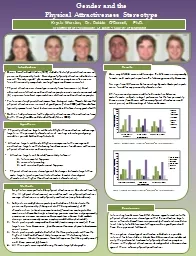

Physical Attractiveness Stereotype Hypothesis Methods Results Conclusions Physically attractive targets will be rated higher than unattractive and average targets in the personality characteristics of ID: 429284
Download Presentation The PPT/PDF document "Gender and the" is the property of its rightful owner. Permission is granted to download and print the materials on this web site for personal, non-commercial use only, and to display it on your personal computer provided you do not modify the materials and that you retain all copyright notices contained in the materials. By downloading content from our website, you accept the terms of this agreement.
Slide1
Gender and thePhysical Attractiveness Stereotype
Hypothesis
Methods
Results
Conclusions
Physically
attractive targets will be rated
higher than unattractive and average targets
in the
personality characteristics of:
exciting, interesting, outgoing, sociable, poised, bold and
sophisticated. Attractive targets will be rated higher in comparison to the average and unattractive targets on the following four dimensions: friendliness, enthusiasm, physical attractiveness and social poise.Attractive targets will be rated “more likely to have…”: A. future marital happiness B. successful parenting C. and social and professional happinessPhysical attractiveness stereotype will be stronger for female targets than male targets (participants will rate attractive female’s stereotypical characteristics higher than attractive male’s characteristics).
Introduction
Dion,
Berscheid and Walster (1972) studied effect of physical attractiveness on perceived personality traits. Stereotype of physically attractive individuals is an overall “beauty is good” phenomenon. Attractive people are often seen as friendlier, socially competent, exciting, happier and more successful. Physical attractiveness stereotype in society from two sources: (a) direct observation of attractive and unattractive people in one’s social environment and (b) exposure to cultural representations of attractive and unattractive people.Preferences for physical attractiveness have biological roots. Theorists believe that physical attractiveness is a result of good genes (Patzer, 2008) and those who have typically symmetrical facial features are considered to have strong genetic health.Studies find preferences for the physically attractive over the unattractive from birth, through middle and late adulthood (Patzer, 2008).
Six photos were pre-tested for physical attractiveness. One of each level of the IV (physical attractiveness) was used for each sex: physically attractive, average attractiveness and physically unattractive (see photos above).Subjects viewed photos separately and rated on a 1-5 Likert scale the perceived personality (1 being not at all- 7 being extremely) of 27 characteristics. (altruistic, conventional, self-assertive, exciting, stable, emotional, dependent, safe, interesting, genuine, sensitive, outgoing, sexually permissive, sincere, warm, sociable, competitive, obvious, kind, modest, strong, serious, sexually warm, simple, poised, bold, sophisticated).Next, participants compared and ranked (least, average or most) all three targets on four dimensions: friendliness, enthusiasm, physical attractiveness, social poise.Next, participants predicted which of the three participants will have the highest likelihood of “most likely to experience” the following future endeavors: Marital happiness , Parental happiness (“will be a good parent”) and deep personal fulfillment .All three parts were repeated using the male target photographs.
One way ANOVA were used to analyze the differences in responses by female and male participants on the following personality dimensions. No significant differences between ratings by male/female participants were found for any personality characteristics.Chi-square analysis were used to find similarities between male/female subjects in target preferences for the four personality dimensions (friendliness, enthusiasm, physical attractiveness and social poise) and for rankings of future endeavors. Figure 1. Male participant ratings for “most likely” on future endeavors. Figure 2. Female participant ratings for “most likely” on future endeavors.
Interesting trends were found that show an opposite reaction to the physical attractiveness stereotype, in that the unattractive targets were often rated much lower on personality characteristics and also least likely to find future marital happiness, be a good parent and have deep personal fulfillment. This negative stereotype of unattractive individuals is a possible interest for future studies. A looks based discrimination includes not only the preferential treatment of physically attractive people as shown in the physical attractiveness stereotype, but a discrimination against those who are physically unattractive.
Krysta Wersten, Dr. Debbie O’Donnell, Ph.D. Department of Psychology, St. Mary’s College of Maryland